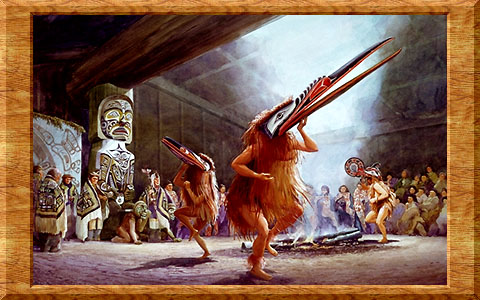
Original watercolour 27" x 39" by Gordon Miller © 1986
This is a depiction of a winter dance in the Sea Lion House at Quattishe, a southern Kwakwaka'wakw village on Quatsino Sound. The large ancestor figure, carved by George Nelson in 1906, supported the main roof beam at the back of the house. The figure has a whale on its chest and coppers on its arms, and stands behind the seat of honour, a plank supported by two kneeling figures.
The wet winters on the coast were known as Tsetseka, the ceremonial or supernatural season. Feasting, oratory and dancing were part of the proceedings, and great energy was devoted to producing illusions of magic and the supernatural, all presented to family and invited guests in the great fire-lit, smoke-filled houses.
Elaborate theatrical performances and ceremonies were an important part of life and, even during the period when potlatches were banned by Government, the traditions were secretly kept alive. Today these traditions are being proudly preserved and passed on at the U'Mista Cultural Centre in Alert Bay, British Columbia.
The Kwakwaka'wakw supported four dancing societies. The most important was the Hamatsa which consisted of a cast of characters and bird-monsters who inhabited the sky-world and ate human flesh. Depicted are three Hamatsa dancers representing Raven, Huxwhukw and Galukwanl ("crooked-beak").
The house post, dance curtain, headdress, talking stick and the masks are all in the collection of the Museum of Anthropology, University of British Columbia.